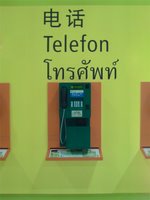Before I start, I need to explain some Chinese opera jargons which I will be using rather frequently in here, so as to avoid confusion.
Hang dang: Refers to the classification of roles a person plays on stage. In typical Chinese opera, there are 4 main classes, the sheng, dan, jing and chou.
Sheng: Typical male roles. The sheng class can be further sub-classified according to age or character. For age-wise, there are wawasheng (young boy), xiaosheng (young male) and laosheng (old male, often bearded). For character-wise, there are wensheng (scholarly male who do not have martial art background) and wusheng (male roles which has martial art background, like warriors, swordsmen, bandits, etc.).
Dan: Typical female roles. The dan class can be further sub-classfied as: xiaodan (very young girl), huadan (young lady), qingyi (matured and/ or graceful lady), laodan (old lady), wudan (female version of wusheng), daomadan (female warriors, not to be confused with wudan) and caidan (clownish lady). Huadan can also have a few different types like guimendan (mix of huadan and qingyi), poladan (sly, vicious lady), kudan (sorrowful lady), etc.
Jing: Male roles with extreme character, be it extremely just (like Justice Bao), extremely loyal (like Guan Yu) or extremely cunning (like Cao Cao). On stage, these roles are characterised by their painted faces, and hence they’re also known as hualian (“flowery” face).
Chou: Male clownish roles (female clownish roles are known as caidan). On stage, these roles are characterised by a white patch painted over their nose bridge. As they looked a bit similar to the jing, they are sometimes known as sanhua.
Shenduan: Refers to an actor’s body language on stage, as well as how well he/ she is able to use the operatic gestures to convey whatever he/ she is required to do so in the show.
This list will expand, when I find that some terms are getting more commonly used in subsequent posts.
Hang dang: Refers to the classification of roles a person plays on stage. In typical Chinese opera, there are 4 main classes, the sheng, dan, jing and chou.
Sheng: Typical male roles. The sheng class can be further sub-classified according to age or character. For age-wise, there are wawasheng (young boy), xiaosheng (young male) and laosheng (old male, often bearded). For character-wise, there are wensheng (scholarly male who do not have martial art background) and wusheng (male roles which has martial art background, like warriors, swordsmen, bandits, etc.).
Dan: Typical female roles. The dan class can be further sub-classfied as: xiaodan (very young girl), huadan (young lady), qingyi (matured and/ or graceful lady), laodan (old lady), wudan (female version of wusheng), daomadan (female warriors, not to be confused with wudan) and caidan (clownish lady). Huadan can also have a few different types like guimendan (mix of huadan and qingyi), poladan (sly, vicious lady), kudan (sorrowful lady), etc.
Jing: Male roles with extreme character, be it extremely just (like Justice Bao), extremely loyal (like Guan Yu) or extremely cunning (like Cao Cao). On stage, these roles are characterised by their painted faces, and hence they’re also known as hualian (“flowery” face).
Chou: Male clownish roles (female clownish roles are known as caidan). On stage, these roles are characterised by a white patch painted over their nose bridge. As they looked a bit similar to the jing, they are sometimes known as sanhua.
Shenduan: Refers to an actor’s body language on stage, as well as how well he/ she is able to use the operatic gestures to convey whatever he/ she is required to do so in the show.
This list will expand, when I find that some terms are getting more commonly used in subsequent posts.


No comments:
Post a Comment